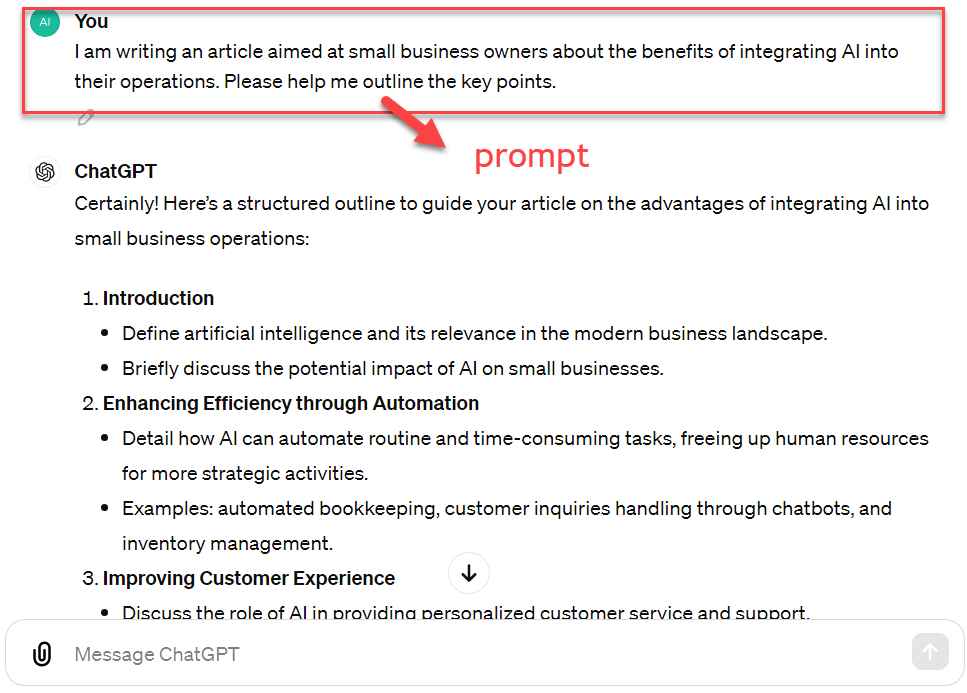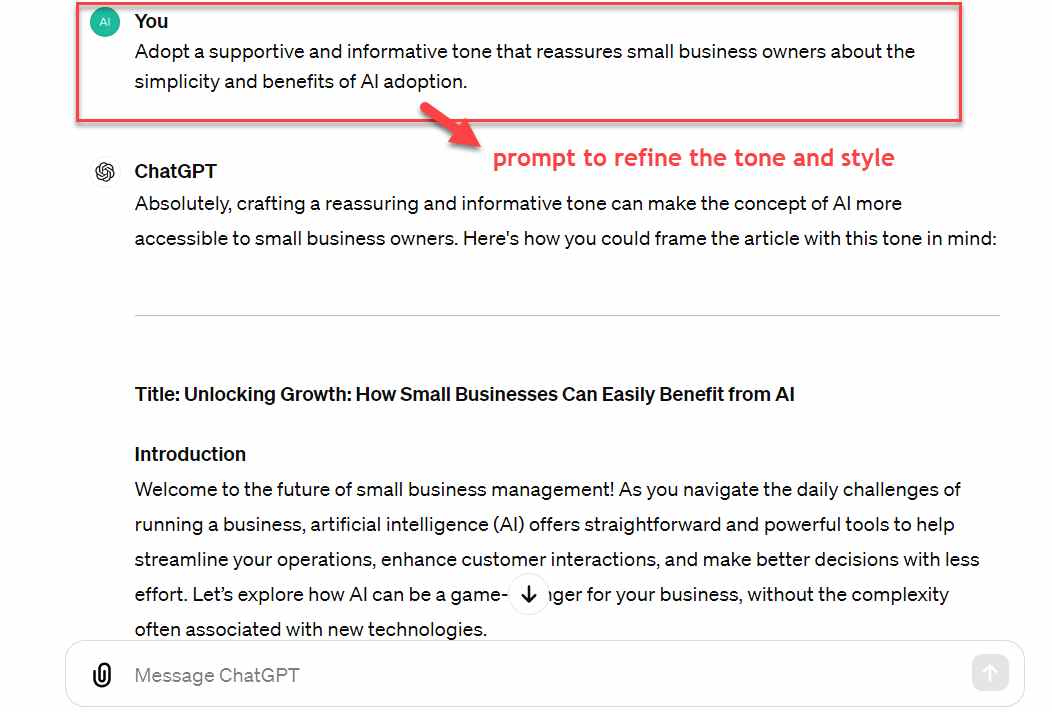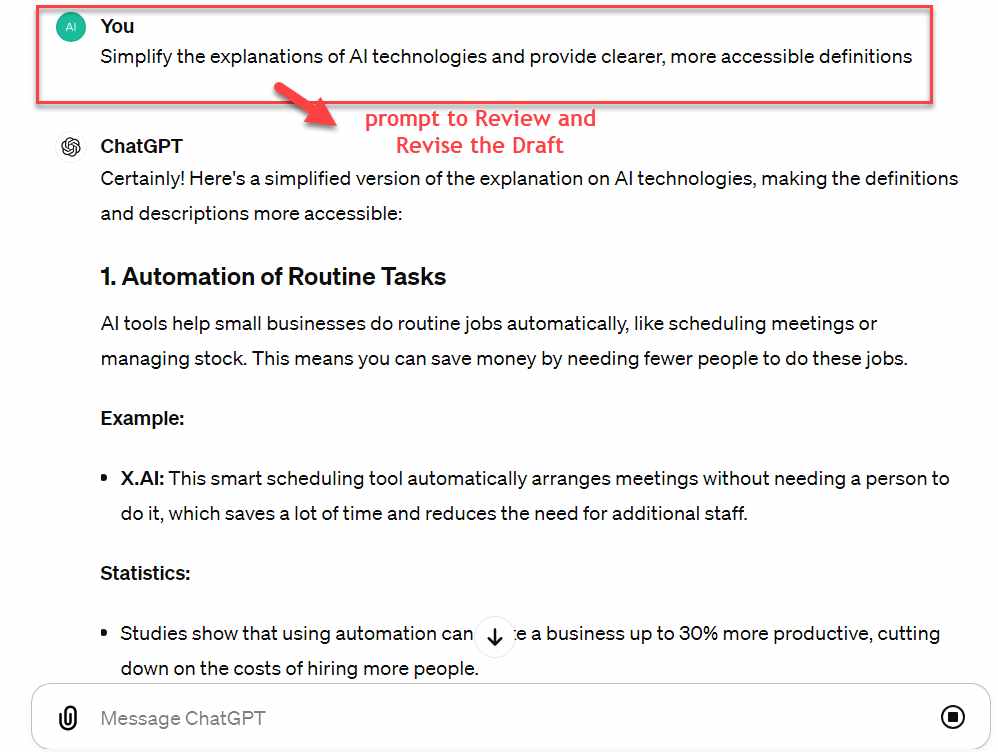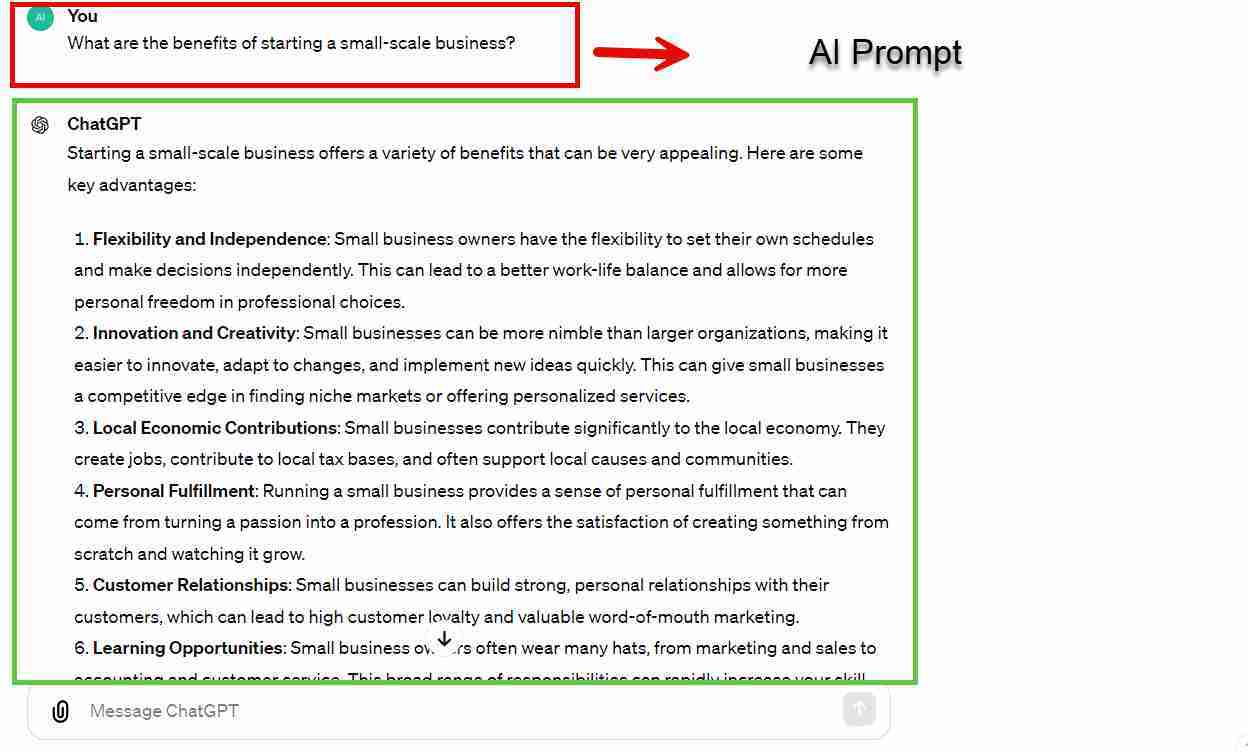ChatGPT, developed by OpenAI, is an advanced AI language model designed to generate human-like text based on the prompts it receives. Its ability to understand and respond to a wide range of topics highlights the significance of learning how to make ChatGPT write like a human.
Making ChatGPT write like a human is crucial for improving user interactions, increasing the accessibility of AI writing tools and techniques, and ensuring that automated responses are both relatable and engaging.
This capability is essential in sectors like customer service, education, and content creation, where natural communication is key to effectiveness.
Identifying the best AI tools for these purposes ensures that communication processes are optimized for clarity, responsiveness, and efficiency.
Read along for a detailed how-to guide on making ChatGPT write like a human.
How to Make Chatgpt Write Like a Human – Step-by-Step Guide
To effectively learn how to make ChatGPT write like a human, follow this practical guide, focusing on enhancing the model’s ability to mimic human-like interactions and expressions:
Step 1: Define the Writing Task and Audience
Step 2: Refine the Tone and Style
Step 3: Expand on Key Points with Detailed Information
Step 4: Review and Revise the Draft
Step 1: Define the Writing Task and Audience
Objective: Clearly identify the specific writing task, target audience, and key messages to set a clear foundation for the content.
Practical Example:
I initiated the conversation with ChatGPT by stating, “I am writing an article aimed at small business owners about the benefits of integrating AI into their operations. Please help me outline the key points.”
This directed ChatGPT to focus on providing relevant information and structuring the content to address the interests and concerns of small business owners effectively.

Step 2: Refine the Tone and Style
Objective: Tailor the tone and style to suit the preferences and expectations of your audience, enhancing engagement and readability.
Practical Example:
Following the initial outline, I directed ChatGPT, “Adopt a supportive and informative tone that reassures small business owners about the simplicity and benefits of AI adoption.”
This guided ChatGPT to tailor the article’s tone to be more approachable and encouraging, fostering a positive reception among readers who might be apprehensive about new technology.

Step 3: Expand on Key Points with Detailed Information
Objective: Develop each section with detailed explanations, data, and examples to add depth and authority to the content.
Practical Example:
I asked ChatGPT, “Elaborate on the cost-saving benefits of AI for small businesses, including real-world examples and statistics.”
ChatGPT responded with a detailed section that included current data and case studies, which added depth and authenticity to the article, making it more compelling and credible.

Step 4: Review and Revise the Draft
Objective: Ensure the draft meets all requirements and maintains high-quality standards through a thorough review and revision process.
Practical Example:
After reviewing the draft, I realized some technical terms might be confusing for the audience. I asked ChatGPT, “Simplify the explanations of AI technologies and provide clearer, more accessible definitions.”
ChatGPT revised the content to be more user-friendly, ensuring that readers without a technical background could easily understand and appreciate the benefits discussed.

What are the Best Practices to Make ChatGPT Write Like a Human
If you want to learn how to make Chatgpt write like a human, here are some effective best practices to consider:
- Provide Detailed Context: Give ChatGPT as much information as possible about the topic, audience, and purpose of the content. Detailed context helps tailor the responses more accurately.
- Use Conversational Prompts: Guide ChatGPT with prompts that are conversational and specific, which encourages responses that are more natural and engaging.
- Incorporate Idiomatic Expressions: Encourage the use of idioms, colloquial language, and expressions that are commonly used in daily conversation to make the text sound more human-like.
- Request Varied Sentence Structures: Ask ChatGPT to vary sentence length and structure to mimic natural human writing, which avoids the monotony typical of robotic responses.
- Emphasize Tone Consistency: Direct ChatGPT to maintain a consistent tone throughout the piece, whether it’s friendly, professional, humorous, or empathetic, to align with how humans typically communicate.
- Implement Iterative Feedback: After receiving an initial draft, provide feedback and ask for revisions. This iterative process refines the output and makes it feel more personalized and polished.
- Use Examples and Analogies: Request that ChatGPT use real-life examples, stories, and analogies, which help in breaking down complex topics and make the content relatable.
- Simulate Emotional Intelligence: Ask ChatGPT to reflect emotional understanding where appropriate, which enhances the human feel of the interaction and content.
ChatGPT writing like an AI Bot vs. ChatGPT writing like a Human
The image below illustrates the differences in prompts that guide ChatGPT to either write like a typical AI bot or mimic human-like writing:
- An unedited simple prompt
- An edited human version prompt
How to Make Chatgpt Write Like a Human – Advanced Techniques
To find out how to make ChatGPT write like a human using advanced techniques, consider these strategies:
- Custom Instructions: Set detailed guidelines for style, tone, and structure to tailor ChatGPT’s responses.
- Fine-Tuning: Use versions of ChatGPT specialized for specific tasks or industries to improve relevance and accuracy.
- Temperature Settings: Adjust the creativity level of responses with temperature settings to balance predictability and novelty.
- External Plugins: Connect ChatGPT to external data sources or APIs for richer, more informed content.
- Role Play: Simulate specific characters or personas to make ChatGPT’s text more engaging and authentic.
- Context Retention: Employ tools that help ChatGPT remember past interactions, improving coherence.
- Syntax Control: Experiment with varied sentence structures and rhetorical techniques to mimic human writing styles.
- Reinforcement Learning: Use models trained with human feedback to align ChatGPT’s responses more closely with human-like outputs.
How to Edit and Refine ChatGPT Given Output
After you have learned how to make ChatGPT write like a human, you can refine and polish ChatGPT’s output to make it resemble human writing, with the following steps:
- Review for Clarity: Ensure the content transitions smoothly and ideas are clearly expressed.
- Adjust Tone: Match the tone to the intended audience, making it neither too formal nor too casual.
- Use Natural Language: Incorporate colloquialisms and idiomatic expressions to add relatability.
- Eliminate Redundancies: Remove repetitive phrases to make the text more concise.
- Enhance Vocabulary: Replace generic terms with specific ones to enrich the text.
- Add Personal Touches: Include personal anecdotes where relevant for a human touch.
- Correct Grammar: Ensure the text adheres to grammatical norms for professionalism.
- Include Sensory Details: Add sensory descriptions to engage readers and enhance immersion.
- Iterate with Feedback: Use reader feedback to fine-tune the content further.
- Verify Accuracy: Check for factual correctness and update any outdated information.
What are the use cases to make Chatgpt Write Like a Human
Here are some key use cases for making ChatGPT write like a human:
- Customer Support: Automate responses in customer service platforms to provide quick, conversational, and human-like support.
- Content Creation: Generate articles, blogs, and social media posts that require a natural, engaging, and human tone.
- Personal Assistants: Enhance virtual assistants in smartphones and home devices to deliver more natural, conversational interactions.
- Educational Tools: Create tutoring and educational content that is engaging and easy to understand for students.
- Email and Communication Automation: Draft emails and other communications that feel personal and are tailored to the recipient’s expectations.
- Marketing and Advertising: Develop marketing materials that resonate with human emotions and persuasions.
- Scriptwriting and Entertainment: Assist in writing scripts for plays, movies, and games where natural dialogues are crucial.
- Therapy and Counseling Aids: Provide support in mental health apps where conversational naturalness can make a significant difference in user comfort.
How Do I Make ChatGPT Write in My Style?
Checkout how I make ChatGPT write in my style with my secret tips mentioned below:
- Feed It Examples: I provide ChatGPT with samples of my writing, such as excerpts from a short story I’ve written. This helps the AI analyze and understand the nuances of my style, genre, and tone.
- Specify Writing Constraints: I instruct ChatGPT to write within specific constraints that reflect my style. For instance, if I write political fiction with complex language, I set these parameters for ChatGPT to follow.
- Use It for Ideation: I use ChatGPT to draft content based on my guidelines, then edit the output myself. For example, if I’m stuck with plot development in my political fiction, I ask ChatGPT to suggest plot advancements.
- Adjust and Rewrite: I accept that ChatGPT’s initial drafts might not perfectly match my style. I use its output as a base and then refine it, ensuring characters and dialogues remain true to my vision.
- Leverage AI for Feedback: I also use ChatGPT to analyze my writing and point out inconsistencies or weaknesses. For example, if my story’s political structure is unrealistic, ChatGPT might highlight these issues.
What Challenges are Faced in Making ChatGPT Write Like a Human
Here are the main challenges you may face when learning how to make ChatPT write like a human:
- Contextual Understanding: Struggling with complex contexts and subtleties.
Example: When discussing a complex topic like quantum physics, ChatGPT might not grasp the depth or implications of expert debates.
- Consistency: Maintaining a consistent tone and style throughout interactions.
Example: It might use technical jargon in one answer and then switch to layman’s terms in another, confusing the reader.
- Emotional Nuance: Inadequately conveying nuanced human emotions.
Example: When trying to comfort someone who is grieving, ChatGPT’s responses might come off as too generic or insincere.
- Repetitiveness: Tendency to repeat phrases, making responses feel robotic.
Example: In answering frequently asked questions, ChatGPT may repeat the same phrases, making the conversation feel stale.
- Cultural Sensitivity: Handling idiomatic and cultural references correctly.
Example: ChatGPT might use idioms or references that are unfamiliar or inappropriate in certain cultural contexts.
- Ethical Responses: Ensuring unbiased and ethically sound responses.
Example: It could struggle with providing advice on ethical dilemmas, failing to consider all moral implications.
- Style Adaptation: Mimicking specific writing styles effectively.
Example: When asked to mimic the writing style of a famous author, ChatGPT might not capture the unique elements that characterize that author’s voice.
Explore How-to Guides for More Inspiration:
Check out these how-to guides for a dose of inspiration! They’ll help you get creative and master new skills.
- How to Humanize AI-Generated Text
- How to write engaging content on pets and animals with AI writing tools
- How to write effective opinion pieces with AI writing tools
- How to write effective policy papers with AI writing tools
- How to use AI writing tools for personal blog writing
FAQs
How do I prompt ChatGPT to sound more human?
Can ChatGPT really write like a human?
Can I use ChatGPT for writing in different languages?
How do I troubleshoot common issues with ChatGPT ?
Wrap Up
ChatGPT possesses transformative potential, enhancing user engagement, and trust across various sectors. Its ability to generate human-like text quickly and accurately exemplifies the revolutionary advancements in AI.
Embracing ChatGPT and similar AI technologies offers immense opportunities for innovation and efficiency. By integrating these advanced tools, you can greatly enhance their productivity and creativity, thus harnessing the full potential of how to make ChatGPT write like a human. Further, you can enhance your more understanding of AI terms by visiting our AI glossary.







